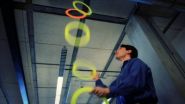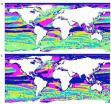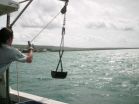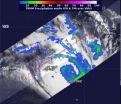(Press-News.org) Juggling may seem like mere entertainment, but a study led by Johns Hopkins engineers used this circus skill to gather critical clues about how vision and the sense of touch help control the way humans and animals move their limbs in a repetitive way, such as in running. The findings eventually may aid in the treatment of people with neurological diseases and could lead to prosthetic limbs and robots that move more efficiently.
The study was published online recently by the Journal of Neurophysiology and will be the cover article in the journal's March 2014 print edition.
In their paper, the team led by Johns Hopkins researchers detailed the unusual jump from juggling for fun to serious science. Jugglers, they explained, rely on repeated rhythmic motions to keep multiple balls aloft. Similar forms of rhythmic movement are also common in the animal world, where effective locomotion is equally important to a swift-moving gazelle and to the cheetah that's chasing it.
"It turns out that the art of juggling provides an interesting window into many of the same questions that you try to answer when you study forms of locomotion, such as walking or running," said Noah Cowan, an associate professor of mechanical engineering who supervised the research. "In our study, we had participants stand still and use their hands in a rhythmic way. It's very much like watching them move their feet as they run. But we used juggling as a model for rhythmic motor coordination because it's a simpler system to study."
Specifically, Cowan and his colleagues wanted to look at how the brain uses vision and the sense of touch to control this type of behavior. To do so, they set up a simple virtual juggling scenario. Participants held a real-world paddle connected to a computer and were told to bounce an on-screen ball repeatedly up to a target area between two lines, also drawn on the monitor. In some trials, the participants had only their vision to guide them. In others experiments, whenever the digital ball hit the onscreen paddle the participants also received a brief impulse on their real-world paddle. This mimicked the sensation they would feel if a real ball had actually struck the paddle they were holding.
With the added touch sensation, also called haptic feedback, the participants made about half as many errors in the task, the researchers reported.
"We have a pretty good understanding as to why," said Cowan, who has been an amateur juggler since middle school. "One of the tricky challenges in juggling is catching a rhythm; that is, getting yourself entrained with the movement of the ball. It's about timing your own action with the action in the environment. When you get the pulse of haptic feedback at the exact moment the ball hits the paddle, it give you a precise sense of the timing for the juggling pattern that you're trying to achieve."
Added M. Mert Ankarali, a Johns Hopkins mechanical engineering doctoral student who was lead author of the study: "The human nervous system gets feedback all of the time from our sense of vision. But the important thing about the sense of touch while juggling is that we get a precise timing cue that complements the continuous visual feedback. This timing cue is very important for us to get the rhythm of the juggling task."
A more surprising discovery was that adding the touch feedback didn't seem to improve the participants' ability to correct for any juggling errors they made while trying to hit the ball into the target zone. But it did enable them to make fewer errors overall. "The haptic sensation is just a tiny bit of feedback that's provided once per juggling cycle," Cowan said. "Yet that tiny bit of information seems to be critical for people to improve their juggling performance. We think that's because while vision provides excellent spatial and positioning information, the haptic information provides very important timing information."
When humans and animals walk or run, Cowan added, their sense of touch plays a key role: As the runner's feet touch the ground, they alert the nervous system to adjust the movement of the legs to accommodate changes in the running surface. He also noted that the brain's ability to instantly integrate information coming from both the eyes and the sense of touch is a critical part of successful running, juggling and other repetitive movements.
The researchers say that future studies of the connection between sensory feedback, timing and limb movements could help clinicians to better understand how some neurological diseases such as sensory ataxia might disrupt the brain's timing of movements by arms and legs. Future findings may also assist engineers who are trying to make touch-sensitive artificial limbs and robots that move as skillfully as animals in the wild.
INFORMATION:
Along with Cowan and Ankarali, the co-authors of the juggling study were H. Tutkun Sen, a Johns Hopkins computer science graduate student; Avik De, a University of Pennsylvania doctoral student who earned his undergraduate degree at Johns Hopkins; and Allison M. Okamura, an associate professor of mechanical engineering at Stanford University.
The research was based upon work supported by the National Science Foundation under grants 0845749 and 642 1230493 to Cowan. Ankarali was partially supported by a fellowship from the Department of Mechanical Engineering at Johns Hopkins. The department is within the university's Whiting School of Engineering.
The journal article is online at: http://jn.physiology.org/content/early/2013/12/20/jn.00140.2013.full.pdf
A related video may be viewed at: A related video may be viewed at: http://youtu.be/GOulwW6b66Q
Digital photos and illustration available; contact Phil Sneiderman.
No clowning around: Juggling sheds light on how we run
2014-02-11
ELSE PRESS RELEASES FROM THIS DATE:
EU rules are denying children latest cancer drugs
2014-02-11
Children with cancer are being denied new, potentially life-saving drugs, because EU rules are allowing companies to trial some drugs only in adults, leading cancer experts warn today.
Changes to how EU rules are implemented could allow children access to a goldmine of potential cancer drugs which have currently only been tested in adults – by making it more difficult for pharma companies to avoid testing them in under-18s too.
Under the current system, pharma companies often gain exemptions from carrying out expensive testing of cancer drugs in patients under the age ...
Heart attack research discovers new treatment target
2014-02-11
New Orleans, LA – Research led by David Lefer, PhD, Professor and Director of the Cardiovascular Center of Excellence at LSU Health Sciences Center New Orleans School of Medicine, demonstrates for the first time cross-talk between two protective signaling molecules during a heart attack. By providing new and important information about the mechanisms involved in heart attacks and organ transplantation, the research identifies a potential new treatment target for heart disease. The paper will be published in Proceedings of the National Academy of Sciences (PNAS) Online Early ...
Point-of-care ultrasound for suspected appendicitis in kids proves accurate
2014-02-11
New York, NY – Using portable ultrasound as a first-line imaging study in kids with suspected appendicitis helps reduce emergency room length of stay and reduces the need for CT scans, according to a team of Mount Sinai researchers. Bedside ultrasound, often referred to as point-of-care ultrasonography, has a specificity of about 94%, meaning that it misses few cases, , the Mt. Sinai researchers add. Results from the study are published online February 10 in the peer-reviewed journal Academic Emergency Medicine.
"From an institutional perspective, this is the most common ...
ASTRO and SSO issue consensus guideline on margins for breast-conserving surgery with WBI
2014-02-11
Fairfax, Va., February 10, 2014 – The American Society for Radiation Oncology (ASTRO) and the Society of Surgical Oncology (SSO) are pleased to announce the publication of the consensus guideline on margins for breast-conserving surgery with whole-breast irradiation in stages I and II invasive breast cancer. The guideline document represents an intensive collaboration among experts in the radiation oncology and surgical oncology fields, led by Meena S. Moran, MD, associate professor of the Department of Therapeutic Radiology at Yale School of Medicine in New Haven, Conn., ...
Maps show expected redistribution of global species due to climate change
2014-02-11
As climate change unfolds over the next century, plants and animals will need to adapt or shift locations to follow their ideal climate. A new study provides an innovative global map of where species are likely to succeed or fail in keeping up with a changing climate. The findings appear in the science journal Nature.
As part of a UC Santa Barbara National Center for Ecological Analysis and Synthesis (NCEAS) working group, 18 international researchers analyzed 50 years of sea surface and land temperature data (1960-2009). They also projected temperature changes under ...
Obese children more likely to have complex elbow fractures and further complications
2014-02-11
ROSEMONT, Ill.─Pediatric obesity is currently an epidemic, with the prevalence having quadruped over the last 25 years. Children diagnosed with obesity can be at risk for various long-term health issues and may be putting their musculoskeletal system at risk. According to new research in the February issue of the Journal of Bone and Joint Surgery (JBJS), obese children who sustain a supracondylar humeral (above the elbow) fracture can be expected to have more complex fractures and experience more postoperative complications than children of a normal weight.
"These ...
Giant mass extinction may have been quicker than previously thought
2014-02-11
The largest mass extinction in the history of animal life occurred some 252 million years ago, wiping out more than 96 percent of marine species and 70 percent of life on land — including the largest insects known to have inhabited the Earth. Multiple theories have aimed to explain the cause of what's now known as the end-Permian extinction, including an asteroid impact, massive volcanic eruptions, or a cataclysmic cascade of environmental events. But pinpointing the cause of the extinction requires better measurements of how long the extinction period lasted.
Now researchers ...
High pollutant levels in Guánica Bay 'represent serious toxic threat' to corals
2014-02-11
The pollutants measured in the sediments of Guánica Bay, Puerto Rico, in a new NOAA study were among the highest concentrations of PCBs, chlordane, chromium and nickel ever measured in the history of NOAA's National Status & Trends, a nationwide contaminant monitoring program that began in 1986.
Researchers from the National Ocean Service's National Centers for Coastal Ocean Science (NCCOS) studied the reef's ecology to help establish baseline conditions that coastal managers can use to measure changes resulting from new efforts to manage pollution. Among the items studied ...
Design prototype chip makes possible a fully implantable cochlear implant
2014-02-11
BOSTON (Feb. 10, 2014) — Researchers from Massachusetts Eye and Ear, Harvard Medical School, and Massachusetts Institute of Technology (MIT) have designed a prototype system-on-chip (SoC) that could make possible a fully implanted cochlear implant. They will present their findings on Feb. 11at the IEEE International Solid State Circuits Conference in San Francisco.
A cochlear implant is a device that electronically stimulates the auditory nerve to restore hearing in people with profound hearing loss. Conventional cochlear implants are made up of an external unit with ...
NASA's TRMM satellite eyes rainfall in Tropical Cyclone Fobane
2014-02-11
Some towering thunderstorms were spotted in Tropical Cyclone Fobane as NASA's TRMM satellite passed over the Southern Indian Ocean on February 10. Fobane was formerly Tropical Cyclone 14S and when it strengthened into a tropical storm it was renamed.
NASA and the Japan Aerospace Exploration Agency manages the Tropical Rainfall Measuring Mission satellite known as TRMM. TRMM has the capability to measure rainfall rates from space and data that can be used to determine the heights of thunderstorms that make up a storm. When TRMM passed over Tropical Cyclone Fobane on February ...



